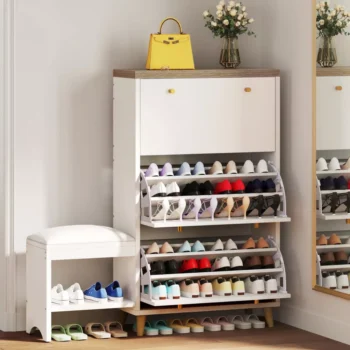How to Choose the Perfect Shoe Cabinet for Your Home
Choosing the perfect shoe cabinet for your home can be both exciting and challenging. It’s not just about finding a storage solution for your footwear; it’s about enhancing your home’s aesthetic and functionality. Here’s a comprehensive guide to help you make the right choice.
1. Assess Your Needs
Before you start shopping, take stock of your footwear collection. How many pairs of shoes do you own? What types of shoes are in your collection? Do you have bulky boots or slim sandals? Understanding your storage needs will help you determine the size and type of shoe cabinet you require. If you live alone, a compact cabinet might suffice. However, a family might need a larger unit with multiple compartments.
2. Measure Your Space
Knowing the dimensions of the space where you plan to place the shoe cabinet is crucial. Measure the height, width, and depth of the available area. This will prevent you from buying a cabinet that’s too large or too small for your designated space. Consider areas such as your entryway, bedroom, or closet. A well-fitted shoe cabinet should seamlessly blend into its surroundings without causing obstructions.
3. Consider the Cabinet Style
The style of your shoe cabinet should complement your home’s decor. Here are a few popular styles to consider:
- Modern: Sleek lines, minimalist design, and neutral colors. Perfect for contemporary homes.
- Traditional: Detailed craftsmanship, wood finishes, and classic designs. Ideal for a more conventional aesthetic.
- Rustic: Natural wood, distressed finishes, and a cozy feel. Great for a farmhouse or country-style home.
- Industrial: Metal accents, rugged designs, and utilitarian appeal. Suits lofts or industrial-style spaces.
4. Evaluate the Material
The material of the shoe cabinet affects its durability, maintenance, and look. Common materials include:
- Wood: Offers a classic and warm look. Solid wood is durable but can be heavy and expensive. Veneer or engineered wood provides a similar aesthetic at a lower cost.
- Metal: Sturdy and modern, metal shoe cabinets are often used in industrial or contemporary homes. They are durable and easy to clean.
- Plastic: Lightweight and affordable, plastic cabinets are practical for children’s rooms or casual spaces. However, they may not be as durable as wood or metal.
- Fabric: Some shoe cabinets feature fabric shelves or covers. These are lightweight and portable but might lack the sturdiness of other materials.
5. Storage Capacity and Configuration
The internal configuration of the shoe cabinet is crucial for maximizing storage. Look for adjustable shelves, multiple compartments, and additional storage features like drawers or hooks. Some cabinets offer dedicated spaces for different types of footwear, such as high heels, boots, and flats. Consider if you need a cabinet with doors to hide your shoes or an open rack for easy access.
6. Ventilation
Good ventilation is essential to prevent odors and mold growth, especially if you store damp shoes. Cabinets with mesh panels, perforations, or slatted designs allow air circulation, keeping your shoes fresh and dry. If you prefer a fully enclosed cabinet, consider adding dehumidifiers or odor-absorbing inserts.
7. Ease of Assembly and Maintenance
Some shoe cabinets require assembly, while others come pre-assembled. Consider your DIY skills and the complexity of the assembly process before making a purchase. Additionally, think about maintenance. Materials like wood and metal require regular cleaning and care to maintain their appearance and durability. Ensure you choose a cabinet that fits your lifestyle and maintenance preferences.
8. Budget
Your budget will significantly influence your choice. Shoe cabinets come in a wide range of prices, from budget-friendly options to high-end designer pieces. Set a realistic budget based on your needs and stick to it. Remember, a higher price often correlates with better quality and durability, but there are plenty of affordable options that offer great value.
9. Multi-Functionality
If you have limited space, consider a multi-functional shoe cabinet. Some models double as a bench, coat rack, or storage unit for other items like umbrellas and keys. Multi-functional cabinets can save space and add extra utility to your home.
10. Personal Preference and Lifestyle
Ultimately, your personal preference and lifestyle should guide your decision. If you frequently change your shoe collection, buy a flexible storage solution. If you have young children, prioritize safety features and durability. Think about how the cabinet will fit into your daily routine and make a choice that enhances your home life.
Conclusion
Choosing the perfect shoe cabinet for your home involves careful consideration of your needs, space, style, and budget. By assessing these factors and prioritizing functionality and aesthetics, you can find a shoe cabinet that not only organizes your footwear but also enhances your home’s decor. Happy shopping!





